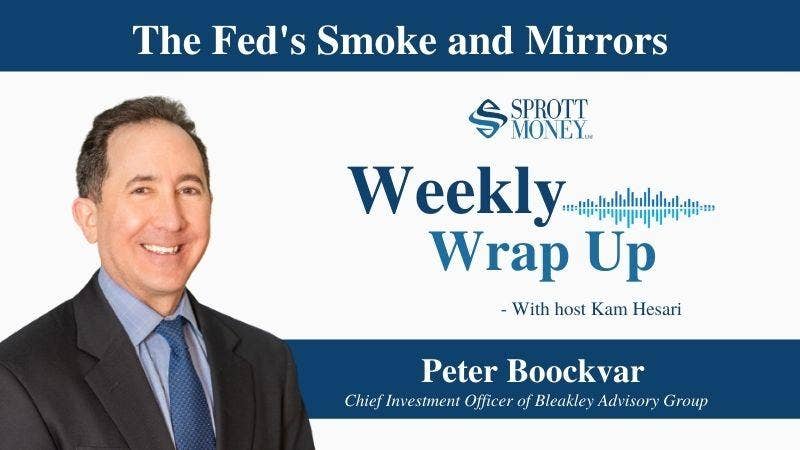Did you know you can get the Sprott Money Weekly Wrap Ups, Ask The Expert,
special promotions and insightful blog posts sent right to your inbox?
Sign up to the Sprott Money Newsletter here.
With Craig taking a much-needed break, Sprott Money’s Kam Hesari welcomes first time guest Peter Boockvar, Chief Investment Officer of Bleakley Advisory Group and Editor of The Boock Report. Listen in as they chat about what to expect in the coming months and how handcuffed the FED is to control it.
In this edition of the Weekly Wrap-Up, you’ll hear:
- Is the Global Tax Agreement really viable?
- The signs of stagflation and underestimated inflation.
- What happens when the U.S. stimulus runs out in September?
- Plus: Which sectors are hot and what sector is not?
“I’m still pretty bullish on energy stocks. I think there is just going to be a multi-year lack of investment that is going to manifest itself into ever higher prices, and a lot of energy stocks are trading below where they were in February 2020. I still think that agriculture has more legs to the bull market. There is still a lot of doubt about that, but I find fertilizer stocks pretty attractive. Obviously very bullish on gold and silver, particularly the miners….” Peter Boockhar, Weekly Wrap Up – 7.15.2021
Announcer: You're listening to the weekly wrap-up on "Sprott Money News."
Kam: Welcome to another edition of "Sprott Money's Weekly Wrap-up." This is Kam Hesari filling in for Craig Hemke. This week's special guest is Peter Boockvar, who is the Chief Investment Officer of Bleakley Advisory Group and the editor of The Boock Report. Welcome to the show, Peter. And thanks for joining us today.
Peter: Thanks so much for having me on.
Kam: Now, before we start, just a reminder that if you enjoy today's podcast, please like, share, and subscribe. Also, make sure to check out our monthly "Ask The Expert" and "Precious Metals Projection" series. All right, Peter, there's a lot of talk about the global tax agreement endorsed by the G20. The deal would impose a global minimum tax on corporations of at least 15%. Now, given U.S. midterm elections are next year and the European Union countries don't have a unified position on this, as countries like Ireland are beneficiaries of low tax policies, do you think it's likely that there will be a deal?
Peter: I'm mixed on it. I think that, at least in the U.S. Congress, it's gonna be considered a treaty. So you're gonna need two-thirds of Congress to pass it or two-thirds of the Senate. I'm not sure the actual protocol with the House, maybe it's two-thirds there as well, and they're just not the votes. So I think right now, this is more theater than anything, and it's not something that's gonna happen this year or even next year. So while it's gaining some press, of course, and a lot of talking points, I think the actual nuts and bolts of getting it passed are pretty slim.
Kam: Completely agreed. Peter, given the U.S. is seven million jobs short of where it was in February 2020 and inflation is spiking, do you think we're seeing signs of stagflation?
Peter: I definitely do. And keep in mind, a lot of those seven million are getting unemployment benefits of some sort. So there's not necessarily lost income by them not working, at least in about half the states left and the rest in September. And then of course, through the end of the year, there's a child tax credit. So we have to understand that just because you are unemployed, doesn't mean you're not actually having money. Now, maybe it's not as much as you did before but there is a level of income that's being sustained because of the government transfer payments.
So to the point about stagflation, we are seeing multiple stagflationary-type situations. I mean, we saw home price gains that were so aggressive, that that in itself helped to slow the pace of transactions because buyers, you know, call the timeout essentially. You have builders that can't deliver enough homes because they can't get enough materials or labor. That is a stagflationary-type situation. You have auto plants that are having to pause, for weeks at a time, assembly lines because it can't get enough parts, it can't get enough semiconductors, that's a stagflationary-type situation.
You have shortages in just about every single good that's out there, so any part of that supply chain to a finished product things get backed up. If you're even a service provider of some sort that relies on its installation or something, well, chances are it's gonna take you time to get your parts to install. This is all slowing-growth, disinflationary environment that's being driven by shortages of a variety of different things including labor.
Kam: Do you think the market is underestimating the inflation shock we're experiencing?
Peter: I think that if you look at... There's a Bank of America survey that I saw a bunch of weeks ago that... They said, "72% think that inflation is transitory." Well, however, you wanna define transitory. I think inflation is never transitory. It's just the rate of change, that is what the debate is. And with respect to services inflation, there's nothing transitory about that. That has risen almost at a near 3% pace annualized in the 20 years leading up to COVID. It's been a good side that has seen basically no inflation on average for reasons of technology, production, efficiency, and so on.
So I think that most people weren't around in the 1970s. Either they were a kid or they weren't born, that are in the financial markets. They have no idea about inflation that remains sticky and persistent. So I don't think we're prepared for that. Certainly, the Federal Reserve is not prepared for that nor is the European Central Bank, who seems to be as dovish as we are here. So there is an acknowledgment of what we're seeing right now. But I think a nonchalance about how long it will last and just the assumption that it's just gonna go away.
Kam: Very interesting. What will happen to the U.S. economy when the stimulus checks run out in September?
Peter: Well, as I mentioned, it's gonna be replaced in a way for...in this child tax credit where there'll be a lot of families that are still gonna be getting money. So we hope that those that were taking their time in filling some of the 9.2 million job openings that we have, that's a record-high, that this will be the incentive for them to go out and fill some of those jobs. We are seeing, obviously, some states that are cutting it off prematurely. And we are seeing, from the studies I've seen, that you're seeing a pickup in job hirings or at least job applications as those benefits wear off. So that's the hope, but it's obviously been a social experiment, where there's been a lot of debate, and I look forward to September to see where continuing claims go in response.
Kam: Peter, given the Fed is in uncharted territory. Do you believe the Fed is deliberately using ambiguous words as a way of hedging?
Peter: Well, yeah. I mean, they are winging it. But that's been monetary policy for a while. But currently, examples of winging it is the Fed talks about, not changing policy until substantial progress has been made. But Jay Powell and his testimony this week admitted he doesn't know how to define that. They are willing to tolerate inflation above the 2% target for "some time" and he can't define what some time means.
They claim that inflation is transitory, but he can't define the word transitory. So that means that they're winging it. But again, they've been winging it for a while. Unfortunately, as opposed to letting the markets decide the price of money, you have, obviously, these government bureaucrats that are trying to do that. Therefore, inherent in that, is that they're winging it. Because yeah, they have their own models, but there's a lot of emotion in institutional groupthink that gets involved here. I mean, you're seeing it a bit large right now.
So Jay Powell is definitely afraid of presiding over any sort of market or economic accident, as his term ends in February 2022. If he wants the job, he certainly doesn't wanna see an accident. And if he doesn't want the job, he wants to hand the keys over, well, he doesn't wanna see an accident towards the end of his term. So there's an actual internal conflict between that institutional groupthink of a bureaucrat, which is essentially what they are, and what they actually should be doing with respect to monetary policy in the space of the economic data that we currently say.
Kam: Do you believe the Fed is in a damned if they do, and damned if they don't situation?
Peter: They are. But they themselves put them in this situation. There's no easy medicine to wean off an economy and markets to the extreme monetary policy that we've seen. But on the other hand, if you just let it continue, you just build up these further excesses. And now we're obviously seeing that manifested in actual consumer price inflation, which, ironically, is what they've been rooting for, anyway, I think mistakenly. So that's why this inflation story is so big because, since '07 when Bernanke went hog-wild with monetary policy, they've been able to get away with it so to speak, since then, because inflation numbers have been low.
Once inflation starts to sort of get unstable, then it handcuffs central bankers' ability to continue on because the market starts to force their hand, the economy starts to force their hand, Main Street starts to force their hand. I mean, that's the thing about inflation right now. It's not just a theoretical debate on Wall Street desks, it is affecting Main Street. And we saw politicians on both sides talking about them getting more calls from their constituency about inflation, particularly on the housing side.
Kam: Given housing prices have been soaring, do you expect any measures from central banks in an attempt to cool housing prices?
Peter: Well, the only way that they can cool it is if they start raising interest rates, and that's clearly not what they wanna do. Tapering is not gonna cool housing because it's not going to lead to a change in interest rates. And if anything, history's shown, at least over the last 15 years of QE, is that when you take it off, your curves flatten, so long rates actually fall. So it won't be until the Fed actually starts raising interest rates, that would be the reason to cool the housing market, but we know that's not gonna happen.
So that's the problem with monetary policy, is that central bankers have an inflated view of their ability to stimulate economic growth and don't appreciate enough how little they can do that, but at the same time causing all these outsize imbalances, particularly, in housing, that then makes it even more difficult for them to eventually get out of this policy when the time comes.
Kam: Peter, can the Fed start tapering at some point without causing a market crash?
Peter: Well, crash is a strong word. I'll say that it's impossible for them to progress through tapering and not have a market correction. The easy monetary policy and the level of market prices are well intertwined. You cannot separate the two. The Fed somehow has this belief that the longer they wait, somehow the easier this process is going to be.
An analogy I like to give is if Mike Tyson is gonna tell you he's gonna punch you in the face, and he gives you plenty of warning, and he communicates that punch is coming, it's not gonna make it any less painful than if he just did it out of nowhere. So I think that's one of the fallacies and instead thinking that if they just wait long enough and they're just patient long enough, that somehow they're gonna be able to exit desk without any harm done. And I think that's just an impossibility.
Kam: Has their policies push desperate yield-seeking seniors into unsuitable investments such as junk bonds?
Peter: For sure. And this has been happening now since the mid-2000s when there was a grab for yield that obviously manifested itself in the housing bubble. But yeah, I mean, I'm the CIO of a wealth management firm. We have a lot of clients that are desperate for income. You have 10,000 baby boomers in the U.S. who are turning 65 every single day. I mean, there is a constant discussion of how do we get clients more income. But the problem is you have to take on more risk and more tolerance for volatility in your portfolio in order to do that. And there are just a portion of retirees that just don't have the stomach for it, but then, on the other hand, have no other means of income, other than what their portfolios [inaudible 00:12:30] and their Social Security check. So it becomes very difficult and it really is a shame that this is still going on after all these years.
Kam: Indeed it is. Stanley Druckenmiller recently stated, "I think it is more likely than not within 15 years, we lose reserve currency status." Is it probable for the U.S. to lose its world reserve currency status?
Peter: I don't necessarily think we'd lose it, I think there's a possibility that we'd share it with the Chinese. I think that they have made it a goal of theirs to be treated on equal footing or at least a level of respect that they feel like they haven't had before, and whether it's the shift to a digital currency in China, that will help to establish that. I think that the competition for that reserve currency status will be intense from China. Now, in terms of losing it, I know we have a history of countries that do that. And I think that if left to its own devices, we'd be headed in that direction considering the lack of respect that we treat our currency when you look at our debts and deficits, or budget deficit, or trade deficit, or current account deficit, and so on, that we don't necessarily deserve it from that perspective. But unfortunately, there aren't other many choices in terms of replacement.
Kam: With the U.S. having a debt-to-GDP of 128%, how long can the U.S. continue living beyond its means?
Peter: I don't know. As long as people continue to finance it. It's hard to answer. I mean, in the mid-1980s, there were a lot of complaints about the skyrocketing U.S. budget deficit and debts. And here we are 35 years later.
Kam: That's a valid point. Where do you see the U.S. Dollar going?
Peter: I think big picture the dollar is going to continue to go down. You can draw a pretty good long-term chart, overlaying the Dollar Index versus the trade and budget deficit, and they pretty much follow each other. I'm sure we'll get some dollar bounces when sentiment and positioning gets offsides. But I think that the dollar is headed lower over a period of time. I think that... Getting back to what we discussed earlier, the Fed will be dragging their feet in terms of removing accommodation. I mean, compared to somewhat other central banks are doing, there was a member of the Bank of England today that said that they've [inaudible 00:15:15], that it's time to start pulling back on QE. Now, the Bank of England has the plans to end it by year-end, but he came out and said, "We may end it much sooner than that."
The Bank of Korea is setting up for an August rate height. The Bank of Canada, again, trimmed their weekly QE. I think there's now pressure on the Reserve Bank of Australia if they can get over the Delta variant in some way, that they're gonna slow down the pace of QE, and I think that's gonna be a growing theme. But the ECB, the BoJ, and Fed will certainly be in the back of the line in terms of removing that. Now technically, the Bank of Japan has slowed because they focus more on yield curve control, which allows them to buy less. So in terms of rate of change and expanding the balance sheets, the Fed and the ECB clearly win that race right now, and therefore the least for the dollar, you know, that's not very positive for one's currency.
Kam: Very sad, but true. Peter, with many governments demonizing fossil fuels, while praising ESG, do you believe silver will be a beneficiary of new government policies?
Peter: I think it's very interesting how silver has sort of carved out a new level of usage of it. Obviously, we relied a lot on the camera and film for eating up silver supply. But a lot of these renewable world that we're in and demands for it, silver is gonna be a very interesting industrial commodity. I mean, silver is just so interesting to me because it has that mix that really... I mean, outside of maybe palladium and platinum, but to a much greater extent silver that you have this industrial demand, and to your point about ever-increasing industrial demand, and a lot of this new, 21st-century renewable world that we wanna transition to. But also, having that monetary aspect, that non-fiat, that money, real hard money aspect. And I think that sort of dual-demand picture makes it a really interesting commodity in today's world or currency if you wanna call it that, too.
Kam: Fair enough. Time for my favorite question. What do you believe is the most lucrative sector right now? And which sector would you not touch with a 10-foot pole?
Peter: I'm still pretty bullish on energy stocks. I think there's just gonna be a multiyear lack of investment that's going to manifest itself into ever-higher prices, and a lot of energy stocks are trading below where they were in February 2020. I still think that agriculture has more legs to the bull market. There's still a lot of doubt about that, but I find fertilizer stocks pretty attractive, obviously very bullish on gold and silver, particularly the miners. I still think that there's some good-value stocks in the U.S. but you know, people are jazzed up by tech, and the excitement of tech and the gains that we've seen in tech and, you know, boring companies are paying good dividends yields, and trading at an inexpensive valuation are just not exciting to many investors, and certainly not that exciting to, you know, many option traders who wanna see quick moves.
But I think that, in this kind of environment where we've had such outperformance of growth versus value, its values turn to outperforming and working out over the next decade, plus, I'm pretty bullish on Asian markets and parts of Europe, again, because of attractive valuations. Now, in terms of what I wouldn't touch with 10-foot poles, there are U.S. technology companies that are just very exciting in their product lines, but a lot of companies that don't make money, and that are trading at such egregious valuations that I don't see how they really ever grow into them. So while I would never short any of them, and I'm fascinated by the technologies, I just think from a valuation perspective, it's just a riskier place to play.
Kam: Peter, the markets have been volatile, to say the least. What do you see the rest of the summer looking like?
Peter: I think the rest of the summer and certainly through the rest of the year, you can throw out your analysis of GDP growth and earnings. It's all gonna come down to the direction of the inflation statistics in the months to come and what the Feds response function is. I made the point earlier that for 10-plus years, central banks have been able to get away with anything they want to because inflation has been low.
And that has allowed them to sort of set their own timeline on how they implement policy, both aggressively with easing and an eventual tightening. But if you get persistent inflation, that potentially could take away their own internal timeline, and that timeline by the markets would get forced upon them. And not just by the markets. It will get forced upon them by pressure from the politicians, pressure from the economy in the sense of inflation slowing things down.
So I think that we've already had four hot core CPI numbers, where core CPI in those four months were annualizing 8.4% rate. I think that once you get the inflation stats in the next couple of months, there will be no more base effect excuses, and we'll see how sticky this inflation is, which I think it will prove to be. Therefore, the Fed can keep talking about, talking about, and talking about things, but the stats will sort of force upon them at the beginning of the taper.
And keep in mind, even if the taper is still gonna last a year, assuming they do 10 billion a month, and that's even before a discussion of when they might raise interest rates. So you wanna talk about behind the curve, they're not just behind the curve... Let's take a street, they're not just behind a street curve, you know, they're like a hundred steps behind, in terms of curves. But to your original question, because I know I'm rambling on here. It'll be the inflation numbers, it'll be the reaction and interest rates, and what the Feds response function will be. In two weeks, are they gonna announce that taper will begin in September at the July meeting? Or are they gonna tell us that they're still discussing it and they'll let us know again in September? That will determine the rest of the summer and then likely into the fall, the market behavior.
Kam: Peter, thanks for sharing your wisdom with us. Please let our viewers know where they can find your work.
Peter: Well, if they wanna see my daily writings, they can subscribe to boockreport.com, it's B-O-O-C-K Report, and they can trail it also. And as we are a wealth management firm, if you're interested in wealth management services, they can check us out at bleakly.com.
Kam: On a final note, it tends to be true that what the wise do in the beginning, fools do in the end. With yields near zero, Japanization may very well be the future of the bond market. Unfortunately, the stock market is also extremely frothy according to the Buffett Indicator, yet silver is still far from its all-time high of $49 and change which occurred in 2011 and 1980.
Given the high demand for silver and limited supply, many believe it's an absolute no-brainer at its current price. If you haven't positioned yourself yet to be a beneficiary of the coming reset, please call us at 1-888-8610-775 to discuss all your bullion options in depth. Alternatively, you can shop online at sprottmoney.com. Well, that's it for this edition of "Sprott Money's Weekly Wrap-up." I hope you found it of value. Please like, share, and subscribe and see you next week.
Don’t miss a golden opportunity.
Now that you’ve gained a deeper understanding about gold, it’s time to browse our selection of gold bars, coins, or exclusive Sprott Gold wafers.
About Sprott Money
Specializing in the sale of bullion, bullion storage and precious metals registered investments, there’s a reason Sprott Money is called “The Most Trusted Name in Precious Metals”.
Since 2008, our customers have trusted us to provide guidance, education, and superior customer service as we help build their holdings in precious metals—no matter the size of the portfolio. Chairman, Eric Sprott, and President, Larisa Sprott, are proud to head up one of the most well-known and reputable precious metal firms in North America. Learn more about Sprott Money.
Learn More
You Might Also Like:

















Looks like there are no comments yet.